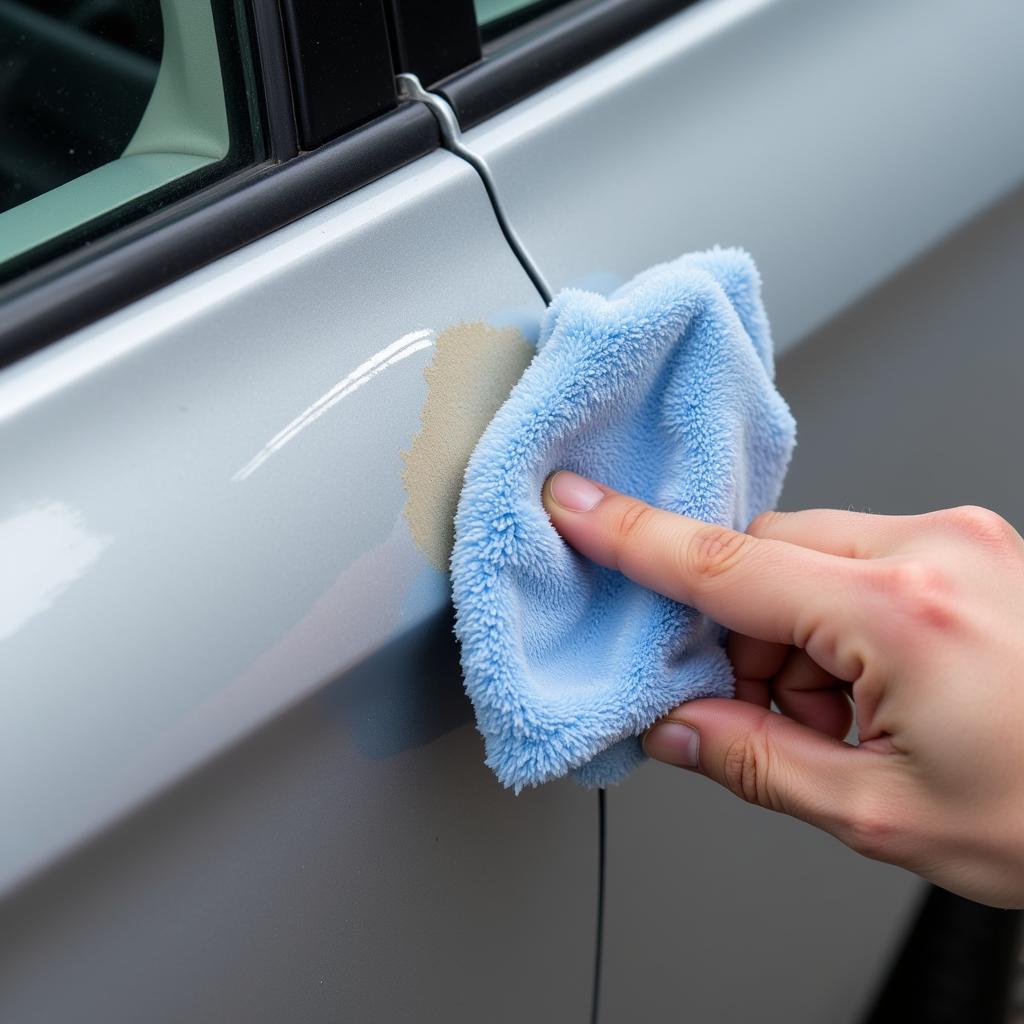Learning how to repair scratches on car with touch up paint can save you a significant amount of money compared to professional repairs. Minor scratches, especially those that don’t penetrate the primer, can often be addressed with DIY touch up paint techniques. This guide will walk you through the process step by step, from assessing the damage to achieving a seamless finish.
A key factor in a successful touch-up is correctly identifying the type of scratch you’re dealing with. Is it a light surface scratch or a deeper gouge that exposes the metal underneath? This will determine the best approach and necessary materials for your car scratch repair. Let’s explore how to tackle these common car paint imperfections effectively.
Assessing the Damage: The First Step in Car Scratch Repair
Before you begin to repair scratches on car with touch up paint, carefully examine the affected area. Clean the scratch thoroughly with soap and water, then dry it completely. This will allow you to accurately assess the depth and severity of the damage. A light scratch that only affects the clear coat may only require polishing. Deeper scratches that penetrate the color coat or primer will require touch-up paint. If the scratch is deep enough to expose bare metal, rust prevention becomes a crucial part of the repair process.
You can find more information about car paint repair costs at our page on small paint repair car cost.
Gathering Your Materials for Touch Up Paint Application
Once you’ve assessed the scratch, gather the necessary materials. This includes touch up paint that precisely matches your car’s color, primer (if the scratch is deep), fine-grit sandpaper, rubbing compound, polishing compound, masking tape, applicator brush or pen, and microfiber cloths. Acquiring the correct color match is crucial for a seamless repair. You can typically find your car’s paint code inside the driver’s side doorjamb, under the hood, or in the owner’s manual. A perfect color match makes the repair virtually invisible.
How to Repair Light Scratches on a Car
For light scratches that haven’t penetrated the color coat, you might be able to buff them out with rubbing compound and polishing compound. Apply a small amount of rubbing compound to a clean microfiber cloth and gently rub the scratch in a circular motion. Follow up with polishing compound for a glossy finish. This method can effectively remove minor imperfections and restore the shine to your car’s paint.
More complex repairs, like peeling paint, can be costly. For a better understanding of these expenses, visit our peeling car paint repair cost page.
Repairing Deeper Scratches with Touch Up Paint
If the scratch is deeper and requires touch up paint, follow these steps:
- Clean and Prepare: Clean the scratch thoroughly with soap and water and dry completely. Mask off the area around the scratch with masking tape to protect the surrounding paint.
- Prime (if necessary): If the scratch has reached the metal or primer, apply a thin coat of automotive primer to the exposed area. Allow the primer to dry completely before applying touch up paint.
- Apply Touch Up Paint: Using the applicator brush or pen, carefully apply thin coats of touch up paint to the scratch. Avoid applying too much paint at once, as this can lead to runs and drips. Allow each coat to dry completely before applying the next.
- Sand and Smooth: Once the touch up paint is dry, use fine-grit sandpaper (2000-grit or higher) to carefully level the paint with the surrounding surface. Wet sanding is recommended for best results. Be gentle to avoid sanding through the surrounding paint.
- Polish and Finish: After sanding, use rubbing compound and polishing compound to blend the repaired area seamlessly with the surrounding paint. This will restore the shine and remove any remaining imperfections.
“When repairing deeper scratches,” advises John Smith, Senior Automotive Technician at Smith’s Auto Repair, “patience is key. Applying multiple thin coats of paint and allowing sufficient drying time between each coat will result in a much smoother and more professional-looking finish.”
When to Seek Professional Car Scratch Repair
While many minor scratches can be repaired with DIY touch up paint methods, some situations warrant professional intervention. Deep scratches that expose significant amounts of bare metal, cracks in the paint, or extensive damage may require more advanced repair techniques. In such cases, seeking professional help ensures a proper and long-lasting repair. Consider visiting our page on car scratches touch up paint repair for more information.
“For deeper scratches or those located on prominent areas of the car,” adds Emily Davis, Lead Paint Specialist at Davis Auto Body, “it’s often best to consult a professional. They have the expertise and tools to achieve a flawless finish.”
Conclusion
Repairing scratches on your car with touch up paint can be a cost-effective and satisfying DIY project. By following the steps outlined in this guide and exercising patience, you can achieve professional-looking results and restore your car’s appearance. However, remember that professional repair may be necessary for more extensive damage.
FAQ
- What type of sandpaper should I use for wet sanding touch up paint? 2000-grit or higher is recommended.
- Can I use any type of touch up paint? No, it’s crucial to use paint that precisely matches your car’s color code.
- How long should I wait between coats of touch up paint? Allow each coat to dry completely, usually about 30-60 minutes.
- Is priming always necessary? Priming is essential if the scratch has penetrated the primer or exposed bare metal.
- How can I find my car’s paint code? The paint code is typically located on a sticker inside the driver’s side doorjamb, under the hood, or in your owner’s manual.
- What if I’m not comfortable repairing the scratch myself? Consult a professional auto body shop for assistance with more complex repairs.
- How can I prevent future car scratches? Regular washing and waxing, careful parking, and avoiding abrasive cleaning materials can help prevent scratches.
Finding the Right Car Paint Repair Service
If you’re looking for professional assistance, we’ve compiled resources for specific locations like car paint repair stourbridge and car paint repair colchester.
Need help with car scratches and touch up paint? Contact us via WhatsApp: +1(641)206-8880, or Email: [email protected]. We have a 24/7 customer support team ready to assist you.



